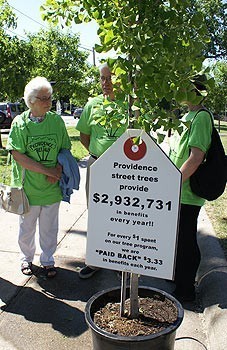
PROVIDENCE – Mayor David N. Cicilline today announced the results of the Providence Tree Tally, an arboreal census of the city streets completed over the past year by a cadre of trained volunteers.
“We know that trees add enormously to the beauty of our neighborhoods and provide countless environmental benefits, but they also require careful management,” Cicilline said. “One hundred dedicated volunteers became our foot soldiers, and spent the past year collecting critically important information about one of our most precious resources, our street trees.”
They found that the city has 24,999 street trees of 95 species, more than 1,000 of which were planted in the past year. Better than two-thirds of the street trees are in good or excellent condition, their tally found, though 409 trees were reported as dead.
The most common species were Norway maple (18.8%), Callery pear (11.6%), green ash (8.6%), honeylocust (7.4%), London plane tree (7.0%), red maple (5.6%) and Zelkova (4.4%).( Additional survey data is posted at www.providenceri.com.)
The volunteers – directed by City Forester Douglas Still – were trained in how to identify a tree’s age, species, size and general condition, and to use handheld devices to record that data along with each tree’s location.
“Now that data about every street tree has been captured in our database,” Still said, “the Parks Department now has valuable information right at our fingertips that will enable us to make smart management decisions about tree pruning, tree rescues, tree plantings and the allocation of resources.”
Data from the Tree Tally also were used to quantify the value to the community of the city’s street trees. For every dollar spent on municipal tree programs, the survey found, the city gets back $3.33 in benefits.
Altogether, officials said, the trees provide $2.93 million in annual environmental benefits – $118 per tree, on average – by intercepting 39,000 tons of carbon and other pollution, collecting 30.6 million gallons of storm water, reducing energy consumption (by providing shade in summer and a windbreak in winter) and increasing property values.
“This is clearly a valuable resource that we need to sustain and grow for the generations that will come after us,” Cicilline said.
The Providence Tree Tally was financed by grants from the Helen Walker Raleigh Tree Care Trust and the Rhode Island Foundation.
To learn more about the city’s street trees and the 2006-2007 arboreal inventory, visit www.providenceri.com.












